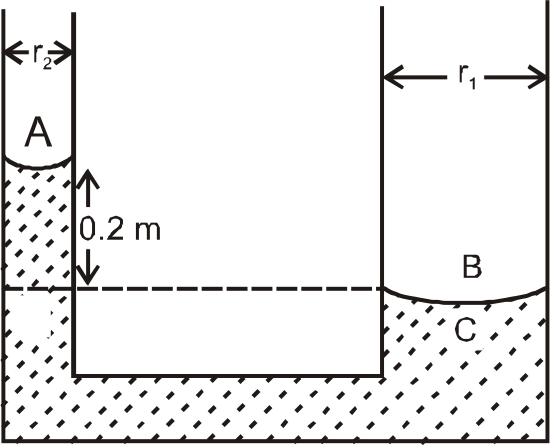A barometer contains two uniform capillaries of radii 1.4×10−3m and 7.2×10−4m. If the height of liquid in narrow tube is 0.2m more than that in wide tube, calculate the true pressure difference. Density of liquid =103kg/m3, surface tension =72×10−3N/m and g=9.8ms−12.
The correct Answer is:A, B
To solve the problem, we need to calculate the true pressure difference between two capillaries based on the given parameters. Here’s a step-by-step breakdown of the solution:
Step 1: Identify Given Values
- Radii of the capillaries:
- R1=1.4×10−3m (narrow tube)
- R2=7.2×10−4m (wide tube)
- Height difference of liquid:
- H=0.2m
- Density of liquid:
- ρ=103kg/m3
- Surface tension:
- T=72×10−3N/m
- Acceleration due to gravity:
- g=9.8m/s2
Step 2: Write the Pressure Difference Equation
The pressure difference ΔP between the two points in the capillaries can be expressed as:
ΔP=P1−P2=ρgH+2T(1R1−1R2)
Where:
- P1 is the pressure in the narrow tube.
- P2 is the pressure in the wide tube.
Step 3: Substitute the Known Values
Now, substituting the known values into the equation:
ΔP=103×9.8×0.2+2×72×10−3(11.4×10−3−17.2×10−4)
Step 4: Calculate Each Component
1. Calculate the hydrostatic pressure difference:
ρgH=103×9.8×0.2=1960N/m2
2. Calculate the surface tension contribution:
- First, calculate 1R1 and 1R2:
1R1=11.4×10−3≈714.29m−1
1R2=17.2×10−4≈1388.89m−1
- Now, find the difference:
1R1−1R2=714.29−1388.89=−674.60m−1
- Now calculate the surface tension term:
2T(1R1−1R2)=2×72×10−3×(−674.60)≈−97.32N/m2
Step 5: Combine the Results
Now, combine the hydrostatic pressure difference and the surface tension contribution:
ΔP=1960−97.32≈1862.68N/m2
Step 6: Final Result
Thus, the true pressure difference P1−P2 is approximately:
ΔP≈1860N/m2
- Radii of the capillaries:
- R1=1.4×10−3m (narrow tube)
- R2=7.2×10−4m (wide tube)
- Height difference of liquid:
- H=0.2m
- Density of liquid:
- ρ=103kg/m3
- Surface tension:
- T=72×10−3N/m
- Acceleration due to gravity:
- g=9.8m/s2
The pressure difference ΔP between the two points in the capillaries can be expressed as:
ΔP=P1−P2=ρgH+2T(1R1−1R2)
Where:
- P1 is the pressure in the narrow tube.
- P2 is the pressure in the wide tube.
Now, substituting the known values into the equation:
ΔP=103×9.8×0.2+2×72×10−3(11.4×10−3−17.2×10−4)
1. Calculate the hydrostatic pressure difference:
ρgH=103×9.8×0.2=1960N/m2
- First, calculate 1R1 and 1R2:
1R1=11.4×10−3≈714.29m−1
1R2=17.2×10−4≈1388.89m−1
- Now, find the difference:
1R1−1R2=714.29−1388.89=−674.60m−1
- Now calculate the surface tension term:
2T(1R1−1R2)=2×72×10−3×(−674.60)≈−97.32N/m2
Now, combine the hydrostatic pressure difference and the surface tension contribution:
ΔP=1960−97.32≈1862.68N/m2
Thus, the true pressure difference P1−P2 is approximately:
ΔP≈1860N/m2
Topper's Solved these Questions
- FLUID MECHANICSBOOK - DC PANDEY ENGLISHCHAPTER - FLUID MECHANICSEXERCISE - Subjective Question
2 Videos
- FLUID MECHANICSBOOK - DC PANDEY ENGLISHCHAPTER - FLUID MECHANICSEXERCISE - Level 2 Single Correct
36 Videos
- FLUID MECHANICSBOOK - DC PANDEY ENGLISHCHAPTER - FLUID MECHANICSEXERCISE - Level 1 Single Correct
49 Videos
- EXPERIMENTSBOOK - DC PANDEY ENGLISHCHAPTER - EXPERIMENTSEXERCISE - Subjective
15 Videos
- GENERAL PHYSICSBOOK - DC PANDEY ENGLISHCHAPTER - GENERAL PHYSICSEXERCISE - INTEGER_TYPE
2 Videos
Similar Questions
A barometer contains two uniform capillries of radii 1.44×10−3m and 7.2×10−4m. If the height of the liquid in the narrow tube is 0.2m more than that in the wide tube, calculate the true pressure difference. Density of liquid =103kg/m3, surface tension =72×10−3N/m and g=m/s2.
View SolutionThe limbs of a manometer consists of uniform capillary tubes of radii 1.44×10−3m and 7.2×104m. If the level of the liquid in the narrower tube stands 0.2 m above that in the broader tube, pressure difference between A and B is found to be 310λN/m2. Here λ is an integer. Find λ (density = 103kg/m3, surface tension = 72×10−3N/m). (take g=9.8m/s2)

View SolutionCalculate the height of liquid column required to balance the excess pressure inside a soap bubble of radius 3×10−3m .The density of liquid is 900kgm−3 and the surface tension of soap solution is 30×10−3Nm−1.
View SolutionWhen a capillary tube of radius 2.8×10−4m is dipped vertically in alcohol , alcohol rises by 0.02m above the outer level. Calculate the surface tension of alcohol, given density of alcohol is 790kg−m−3.
View SolutionTo what height does the liquid rise in a capillary tube of radus 0.25 mm, when dipped in a liquid of density 0.8×103kgm−3 and surface tension 0.05 N m−1? Given (cosθ=0.4)
View SolutionCalculate the pressure due to a water column of height 100 m. (Take g=10ms−2 and density of water =103kgm−3).
View SolutionCalculate the speed of longitudinal wave in steel. Young's modulus for steel is 3×1010N/m2 and its density 1.2×103kg/m3
View SolutionCalculate the speed of longitudinal wave in steel. Young's modulus for steel is 3×1010N/m2 and its density 1.2×103kg/m3
View SolutionRadius of a capillary is 2×10−3m. A liquid of weight 6.28×10−4N may remain in the capillary, then the surface tension of liquid will be:
View SolutionFind the greatest length of steel wire that can hang vertically without breaking. Breaking stress of steel =8.0×108N/m2. Density of steel =8.0×103kg/m3. Take g=10m/s2.
View Solution
